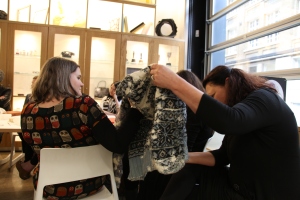It was a privilege to spend an afternoon with UCL’s wonderful rare book conservators (led by Fred Bearman) and Celia Pym, darner extraordinaire. Aside from anything else, it reminded me how good some people are with their hands, and how painstaking even the smallest repair job can be. The great bibliographer Fredson Bowers once suggested that every scholar, ‘for the humility of his soul, ought to study the transmission of some appropriate text’; but if it’s humility we’re after, we should all be forced to fix a broken book.
 Just as some of our much-cherished texts had come away from their covers, the afternoon seemed to slip free of the key terms it was supposed to explore. In his history of the field of book preservation, Fred explained how ‘restoration’ has generally given way to ‘conservation’; and while he clearly feels strongly about the books that come into his care I would describe many of the issues raised by his presentation as ethical rather than emotional.
Just as some of our much-cherished texts had come away from their covers, the afternoon seemed to slip free of the key terms it was supposed to explore. In his history of the field of book preservation, Fred explained how ‘restoration’ has generally given way to ‘conservation’; and while he clearly feels strongly about the books that come into his care I would describe many of the issues raised by his presentation as ethical rather than emotional.
I was struck by how quickly the juxtaposition between Fred and Celia settled on questions of use. And I was reminded of the example that I used to open my chapter on the history of attitudes toward marginalia in my study of readers’ marks, Used Books, to show that we bring different assumptions, values and even language to the objects that come down to us from the past. I started the essay with two descriptions of Renaissance prayer books:
1) …black letter, each title within a woodcut border; the blank margin…skilfully renewed; each work rather soiled by use but sound copies….
2) This volume, printed during the reign of Elizabeth I, has been well and piously used. Marginal notations in an Elizabethan hand—comments and scriptural quotation—bring to life an early and earnest owner.
What made these two quotations so poignant, and so revealing, is that they were both describing the same copy of the same book.